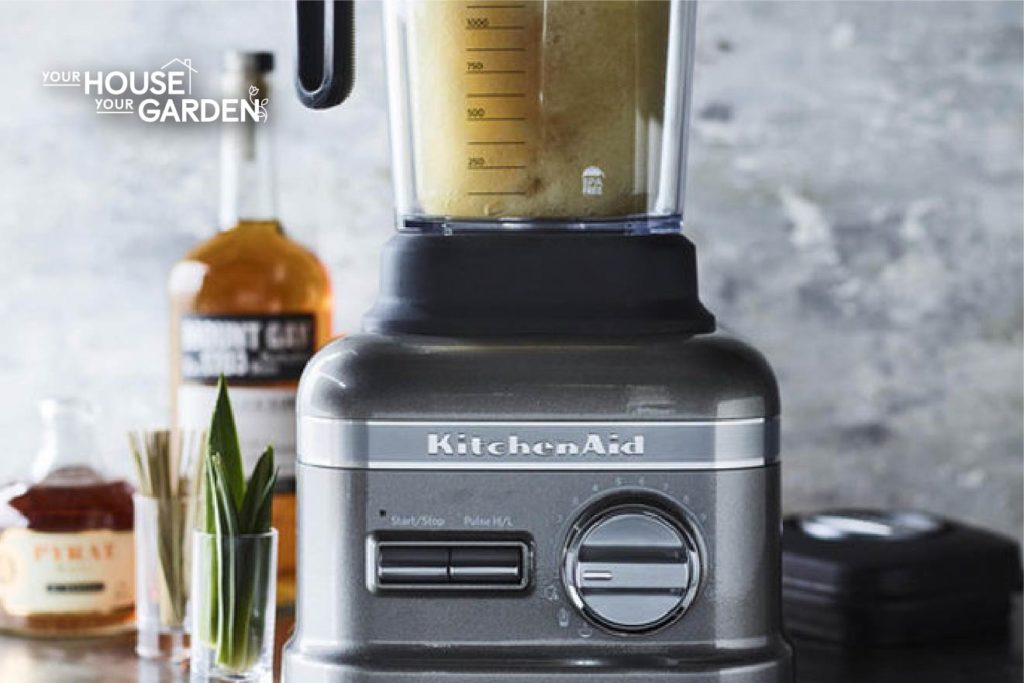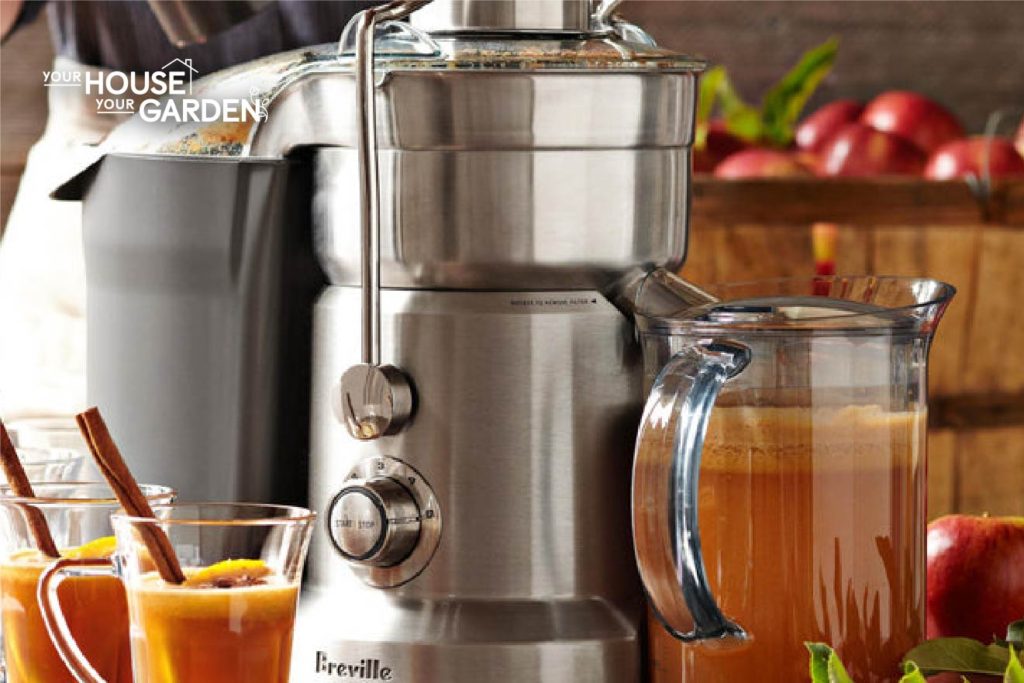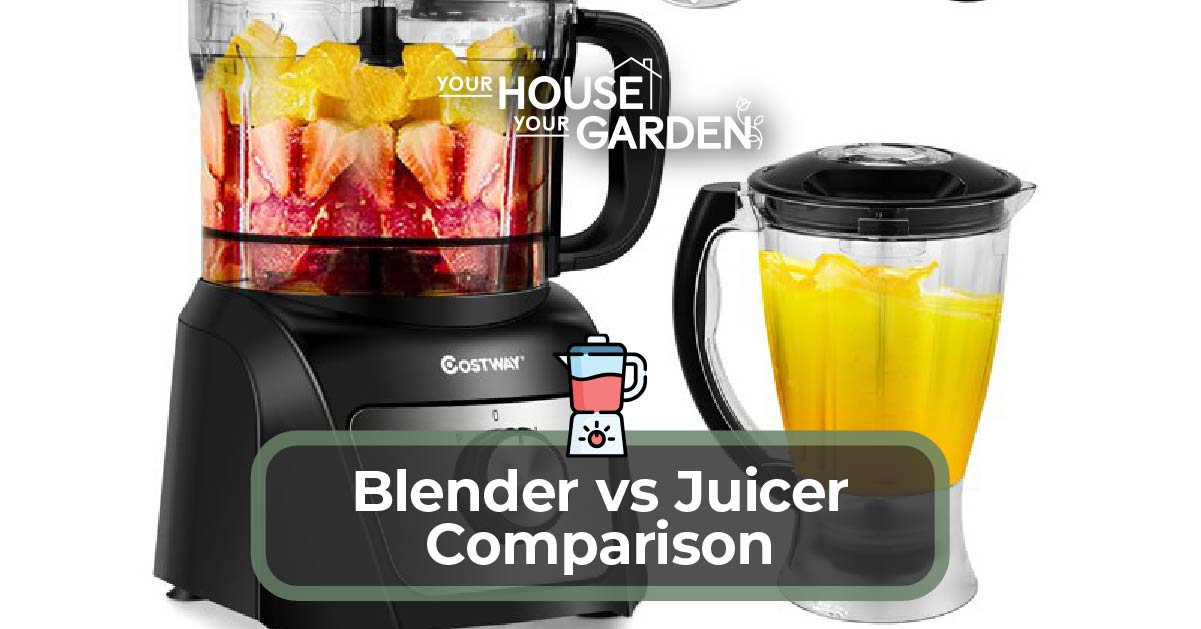Blenders have become one of the go-to appliances for processing foods in homes today. They help us make healthy smoothies, soups, drinks, and lots more: so do we really need a juicer?
Even though blenders seem like they can perform the tasks of juicers, these appliances have got varying roles in the kitchen: hence, the need for the blender vs juicer comparison guide.
Let’s find out the differences between a blender and a juicer.
Differences Between A Blender and A Juicer
The main difference between a blender and a juicer is in the result of the processed food.
Blenders are appliances with sharp blades for pulverizing vegetables, fruits, and/or other ingredients to make thick, creamy liquid such as smoothies while juicers are appliances that extract only the clear juice from the produce they process.
To better understand the difference between these two best vegetable and fruit processors, let’s explore them individually.
What is a blender? A blender is a kitchen appliance for processing vegetables, fruits, and other kinds of foods and items into smooth, thick liquid mixtures.
Blenders have sharp and powerful blades that can pulverize and thoroughly mix ingredients such that there’s no waste. Blending ensures that all the components of the ingredients (the juice and pulp which contains fiber) that you put in the appliance gets mashed up and goes into the final content making the end product very nutritious and more filling. The fiber also aids in digestion and reduces the chances of constipation.
Blenders are versatile appliances and they can be used in blending, crushing, mixing, and pureeing recipes to make delicious soups, purees, cocktails, sauces, smoothies, and dips, etc.
What is a juicer? A juicer is an appliance for extracting liquid from vegetables and fruits leaving behind the skin, pulp, and seeds.
The juice that comes out of the juicer is clear and has high water content. It’s also rich in vitamins and releases these nutrients straight into your bloodstream without the juice having to pass through longer digestive cycles. But it’s low in fiber and lacks some vital nutrients due to the pulp being separated from the liquid.
Also, you’ll need to blend a large number of vegetables or fruits to fill your container since you’ll be left with a smaller quantity of liquid that’s mostly watery. The silver lining is that you’ll get to consume more veggies and fruits in one cup.
Another thing worth knowing is that not all fruits are good for juicing. Starchy fruits like bananas aren’t great to be used with a juicer. The best kinds of fruits that can go in a juicer are soft fruits.
One good thing about juicers is that some models come with attachments for producing thicker and pulpier liquid.
Superiorities of a blender to a juicer
The benefits of owning a blender over a juicer are that they’re more affordable and versatile than juicers. And they have a larger capacity for whipping up healthier drinks that will make you feel fuller.
More versatile
When compared to a juicer, a blender is more versatile.
Blenders are used for crushing ice, pureeing sauces, blending fruits and vegetables, making smoothies, and mixing ingredients that drip of soup. They can also blend some fruits such as bananas that juicers can’t process. In addition, blenders can make baby food and chop or slice meat, fruits, and veggies. Here are the use cases of a blender.
Juicers, on the other hand, can only make juice of your produce and most times, not serve any other purpose.
Healthier drinks
Blenders are capable of producing healthier drinks than juicers.
First, juicing produce isn’t the best option for diabetics and people on weight loss diets. Juicing a fruit requires processing more quantity of the produce which in turn means consuming more of the produce in one cup. If the ingredient is a fruit, the consequence is that more fruits means increased calories and sugar levels.
However, when you blend the produce, you have both the pulp and the juice in your cup, giving you the feel of consuming whole fruits. This also makes you reduce the volume of fruits or veggies in your drink.
These fibers also contain polyphenols that are believed to help prevent cardiovascular disease and some cancers.
Secondly, juicing only releases the vitamins in your produce while blending releases both the vitamins, phytonutrients, and fibers that your juicer discarded.
Satisfies hunger
When compared to juicing, blending produces emulsions that will satisfy you more and fill up your stomach. This is because the drinks contain fibers that make them thick and take a longer time to digest.
Also, energy is released slower in smoothies and other blended drinks than in juiced drinks. The nutrients in juices go straight into the bloodstream without passing through the long digestive process.
Larger capacity
A blender can serve between four and eight cups of drinks which should be enough for a standard-sized family. Meanwhile, the amount of juice you’ll get from a juicer is limited to the size of the collecting container.
More affordable
Despite blenders being more versatile, they’re cheaper than juicers. The cost of a blender ranges from $20 to $600 while the price of a juicer costs between $20 and $700.
Ease of cleaning
When comparing a blender to a juicer, a blender is easier to clean. This is because they have fewer components for you to disassemble and wash. Juicers, on the other hand, tend to create a mess and they have more parts to clean which could be time-consuming and a bit difficult.
Superiorities of a juicer to a blender
The benefits of owning a juicer over a blender are that it helps you consume more fruits in one cup: meaning you get to take in more nutrients that will be easily absorbed directly into your bloodstream rather than passing through long digestive cycles.
More concentrated nutrients
Unlike blending where both the juice and pulp end up in your cup, juicing extracts the juice from the pulp, leaving you with a clear drink. This way, you’re able to brew more veggies and fruits and pack more nutrients into your drink.
Easily digestible nutrients
When you need an instant burst of energy, the best tool to give you energy-rich drinks is the juicer. This is because juicers extract only nutrient-rich liquid from your produce, leaving behind the skin, seeds, and pulp: pulp slows down digestion.
Secondly, the extracted juice contains vitamin C and antioxidants that aid faster absorption: this is particularly good for athletes. And some juices such as cherry and beet juices have been shown to be performance enhancers.

Food Differences between A Blender and A Juicer
Blending and juicing are two methods of adding more fruits and veggies to your diet. But not all items are good enough to go in a blender: the same goes for juicers. Let’s find out some of the items that are great for juicing and those for blending
What foods can be used with a blender?
A blender is great for processing the following foods;
- Beverages: frozen drinks, smoothies,
- Frozen desserts such as ice cream
- Sauces: salsas, hummus, pesto, vinaigrettes, mayonnaise, spreads
- Hot or cold soups
- Soups: roast carrot soup, tomato soup, chickpea, and chili soup
- Grains and cereals: oat flour, cook crumbs, breadcrumbs, almond flour
- Batter: pancake, muffin
- Broccoli rice
- Baby food
- Peanut butter
- Bananas
When using your blender, never put very hot liquid, coffee beans, dried fruits, bones, and potatoes in it.
We’ve described in detail how to use a blender here.
What foods can be used with a juicer?
Juicers aren’t only used in making juices out of fruits. They can do a lot more;
- Fruits: apples, mangoes, oranges, plums, cherries, berries, melons, pears
- Vegetables: carrots, cucumbers, fennel, parsley, wheatgrass, tomatoes, celery
- Dips and soups
- Homemade crackers
- Nut butter
- Ginger
- Smoothie booster
- Baby food
- Almond milk
- Sweet potatoes
- Salad topping
- Nice cream
- Hash browns
Using a blender and a juicer together
You can use a juicer and a blender together in a kitchen. Blending is used in making nutritious purees that are rich in fibers which aid digestion while juicing produces sweeter tasting and easily digestible juices with high nutrient content for quick release of energy.
What are the instances where an air fryer and a wall oven should be used together?
Blenders are designed for making purees and emulsions such as smoothies and soups while juicers are made to make nutritious juices. So when you want to enjoy a healthy, delicious dinner with your family, you can blend your tomatoes, peppers, and onions in your blender for tomato sauce. And before serving the dish, you can use your juicer to blend a mixture of fruits for a few tasty cups of juice.
What are the instances where an air fryer and a wall oven should never be used together?
For diabetics or people on a weight loss diet, using a juicer alongside a blender is not advised as it can increase your calories and sugar levels.
Blender vs Juicer Purchasing Tips
Before spending a couple of $100, you want to be sure you’re getting your money’s worth and not some appliance that will break within a few months. Here are the questions you should ask before you get your next or first blender or juicer.
What type of blender or juicer should I get?
There are four types of blenders; conventional blenders, high-performance blenders, single-serve blenders, and immersion blenders.
Conventional blenders are designed for users that don’t blend often to perform light tasks (such as making salsas and soups). They’re not as durable as other higher-end models and can’t perform heavy-duty tasks (like blending nut butter) as they’re made of cheap materials.
High-performance blenders, also called professional blenders, are more powerful than conventional blenders and are designed for professional chefs or home cooks that cook often. They can carry on heavy-duty tasks such as blending larger volumes of produce and thicker produce. Although they’re more expensive than conventional models.
Single-serve blenders, also known as personal blenders, are designed to make only a cup of smoothie or your favorite healthy drink as they come with small containers. They can’t make drinks for a family, and they’re not ideal for making soups and sauces.
Immersion blenders, also known as hand or stick blenders don’t come with containers. You’ll have to dip the stick blender into the container containing the produce and puree it into a soup. They’re not as powerful as the other models and are limited in their functions.
For juicers, there are also four types; citrus juicers, centrifugal juicers, cold press juicers, and twin gear juicers.
A citrus juicer, also called a citrus press, is specifically designed for juicing citrus. They’re easier to use, clean, and are more compact when compared to the other types of juicers. If you aren’t interested in juicing other types of fruits and vegetables other than citrus, then a citrus juicer will be good for you.
Centrifugal juicers, also called juice extractors, are the most common types of juicers. They’re good for juicing both fruits and vegetables: however, leafy greens and wheatgrass don’t come out well. Also, because they’re very fast, they produce so much heat that depletes the nutrient in your juice.
Cold press juicers, also known as masticating juicers, are slower than centrifugal juicers: hence, they brew more nutritious juices. And they’re capable of juicing more fruits and veggies than centrifugal models. However, cold press juicers take up more countertop space and are more expensive.
Twin gear juicers are more sophisticated, larger, and expensive than cold press juicers. They’re also the slowest in operation, but they yield nutrient-rich juices that stay fresh for longer. Aside from making juices, they can also be used in making pasta and bread.

How much should I pay for a blender or juicer?
Blenders and juicers cost virtually the same amount. However, blenders are more versatile. If you plan on making fruits and vegetables a more integral part of your diet, you can get a good blender for prices ranging from $150 and $200. A juicer that costs around $250 will be good enough to juice drinks for you often and serve you for 10 years.
Countertop and storage space
Most blenders should be easy to store, but immersion and personal blenders are the most compact. Also, since the distance between countertops and the bottom of cabinets ranges from 20 to 22 inches, consider a model that’s less than 17 inches tall.
For juicers, a conventional juicer is the most compact, but centrifugal juicers are more common due to their versatility and cheaper price points. Cold press and twin gear juicers tend to be bulkier and more difficult to store.
What power is good enough?
If you plan on blending foods a lot, you should consider getting a blender with power ranging from 1200 to 1500 watts. While a juicer with a minimum of 400 watts should be powerful enough to juice your leafy greens.
Best brands for blender
The five best blender brands are Breville Hamilton Beach, Cuisinart, Vitamix, and Dash.
Breville
Breville is one of the best brands making some of the best blenders. Their blenders are usually quiet and high-performing. They make a range of immersion, conventional, and high-performance blenders that have won the hearts of many.
Hamilton Beach
One of the most reputable names making some of the best kitchenware is Hamilton Beach. Their blenders are budget-friendly but don’t compromise on quality. However, they don’t compare to higher-end models that can crush larger amounts of produce.
Cuisinart
Cuisinart is a household name making some of the best kitchen appliances. They sell top-quality conventional, high-performance, and single-serve blenders with impressive reviews. Their models are priced moderately.
Vitamix
Vitamix makes some of the most powerful blenders since that’s their specialty. Their blenders tend to be more expensive than most other models but they deliver top-quality performance. Their models consistently have positive reviews.
Dash
Dash is another popular name making some of the best kitchen appliances. Their models come packed with a high level of power especially since they mostly make high-performance blenders. Generally, their blenders have lots of positive reviews, and many people think they’re a great bang for the buck.
Best brands for air fryer
The five best juicer brands are Hamilton Beach, KitchenAid, Breville, Dash, and Kuvings.

